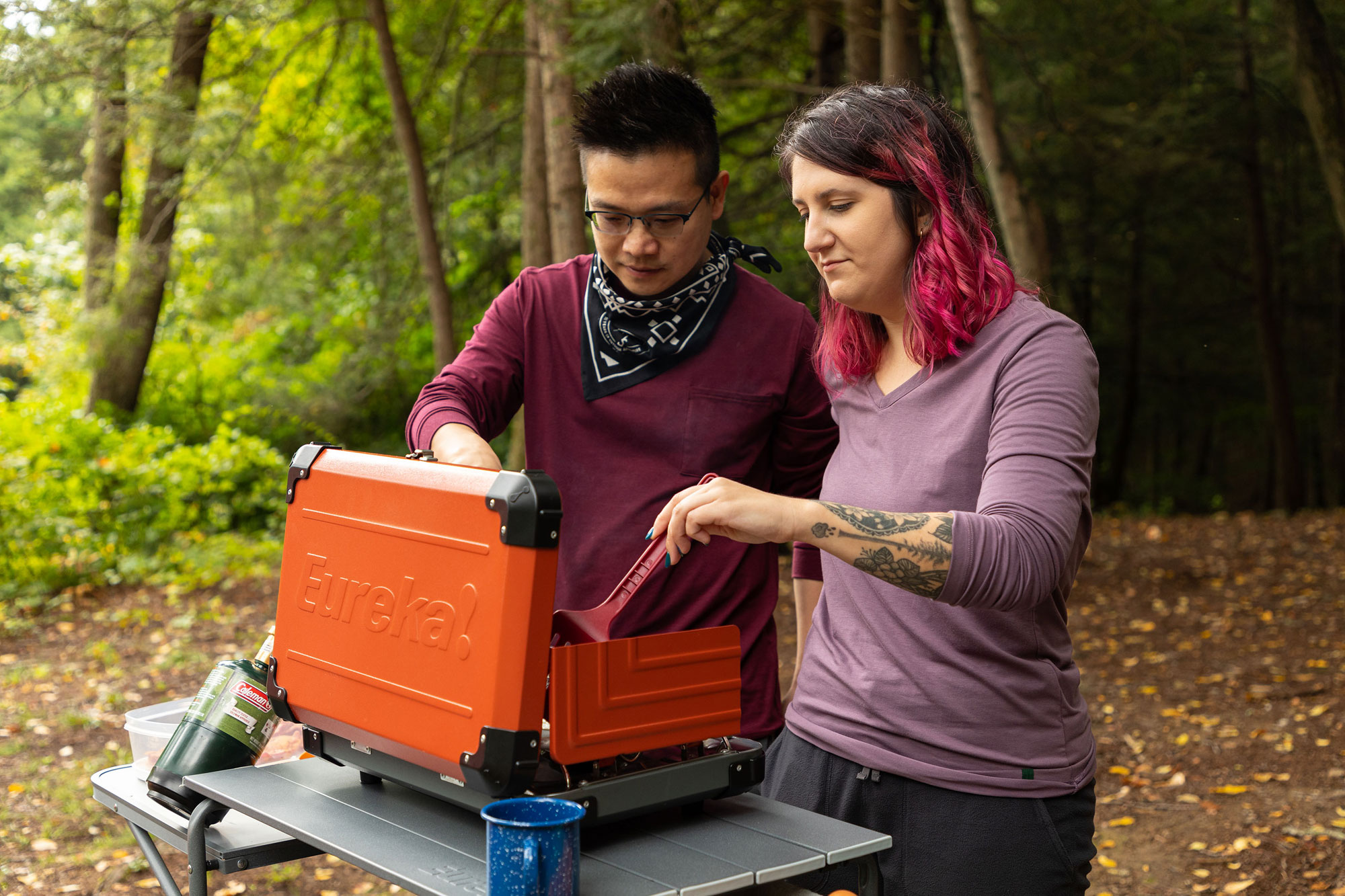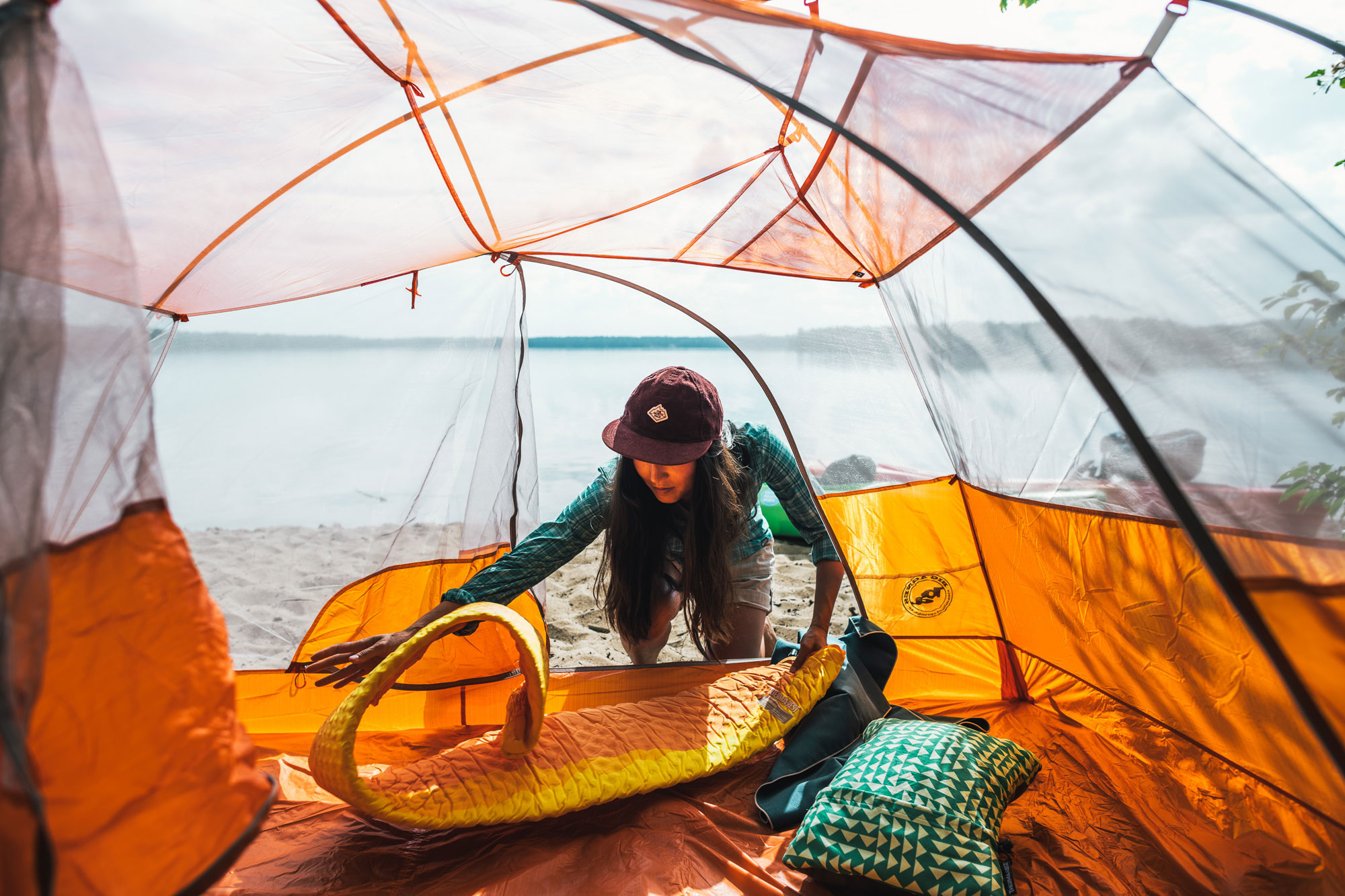If you’ve recently discovered all that being in nature has to offer, camping is a natural next step in delving further into your outside exploration. Car camping at an established campground is a great way to immerse yourself comfortably in the outdoors overnight —Yes, it has it’s disadvantages to backpacking (like possible noisy neighbors), but for someone looking to work their way to longer excursions, this is a great way to start (plus, most campgrounds have quiet hours). We’re going to cover some tips as well as some budget-friendly gear to get you going.
First thing’s first. Try to book your campsite ahead of time— Reserve America and recreation.gov are two options. Note that many campgrounds close mid-late October, although you will find a few year-round hosts that are an exception (we don’t recommend camping for the first time in cold weather months— Save these tips so you can gear up for Spring). Another note for beginner campers is to try finding a place close-ish to home. But what do you need to make sure you have with you?
1. Shelter
When car camping, you don’t need to worry about weight or pack size, as long as you have room in your car. We recommend opting for a comfortable 3-season tent—especially if you’ll be sharing space with others. Eureka makes some awesome entry-level shelters, like the Space Camp 6 Person Tent. The new EMS Northbrook series is perfect for both first-timers and seasoned campers looking for a simple setup (available in 2 and 4-person). Always plan for the elements, because there is nothing worse than waking up to water in your tent when all you want is warmth. In addition, a simple tarp and cord can go a long way and are worth keeping in your car.
2. Sleeping Gear
A simple sleeping bag will do for car camping, because you can always throw more blankets in for added warmth (be mindful of what time of year you’re going and the region’s weather). If you’re shopping around for a bag, the best bang for your buck is the EMS Bantam 35/50, which has an adaptive reversible functionality. For added creature comforts, The Marmot Zuma 30 unzips to convert into a quilt, with internal handles you can grab and wrap around your shoulders at the campfire to keep you comfortable at 30°F. We also have no qualms about air mattresses—If you have the room in your car and want to be comfortable, why not? But if you see yourself ever considering backpacking, think about picking up a sleeping pad, which is a surprisingly comfortable space-saving option.

3. Clothing
Always bring rain gear (like the EMS Thunderhead line) and insulating layers, because…well, New England. Also consider keeping a spare pair of socks around (or a few) and some base layers. When camping in the fall, I always bring some hand warmers for good measure. Bring footwear for whatever activities you’re planning nearby, and a pair of comfortable throw-around shoes for hanging at camp. All in all, think layers. Our tried and true down insulated Feather Pack Jacket is definitely an adventure staple to consider.
4. Fire
Learn the rules and regulations— both in general and in the region in which you’ll be camping— around having a campfire. If you can have one safely, a campfire really makes your camping trip stand out. Most, if not all, campgrounds have a designated fire ring to use. There are plenty of resources online with tips and techniques on how to get one started (don’t forget the small but crucial tool here: the lighter). Natural fire starters like lint or fatwood will help you get lit in no time. A fire is more enjoyable with a comfy camp chair, too.
5. Food
Truthfully, an all-out kitchen kit can get expensive. Most of the time for car camping trips, tools from your home kitchen can suffice when food prepping at a campsite (i.e., wooden spoon, spatula, cutlery, cups, bowls, etc). If you’re looking to get cheffy at camp though, you can invest in some pretty awesome pieces of cookware, like the Eureka Ignite Camp Stove, which has that awesome JetLink compatibility feature so you can connect to other Eurekas. I’ve had my eyes on the MSR Flex 3 Cooking System for some time now; It has all the stacking essentials for you and your team. If coffee is a camping must-have for you, the Eureka Camp Cafe Coffee Brewer is magnificent and will result in you becoming the forever favorite of the group. If you’re opting for a simpler setup though, this MSR MugMate Coffee/Tea Filter will do. We have a range of coolers by YETI, but my go-to is something small and simple like this STANLEY Adventure Easy Carry 16 QT Outdoor Cooler. Always be sure to keep food storage at top of mind— and don’t leave food out overnight.
If you have some roast-able veggies or food that is pre-prepared, you can just wrap it in some tinfoil (or bring a pan from home) and put it over the fire (some/most fire rings have grates). The classic frank on a stick is also delicious. But honestly, I am probably the wrong person to ask if you want to get more involved than that, because I usually just heat up some soup. (I can, however, suggest Good-To-Go’s New England Corn Chowdah). Also worth noting is that you’re campsite will mostly likely have a picnic table.

6. Amenities
Most, if not all campgrounds have water spigots and bathrooms of some kind. Some are more lavish than others (i.e. coin-operated showers are amazing), so call in advance if you’re particular about that sort of thing and always have a gallon of water around.
7. Important Extras
Headlamps are key. Lanterns like this Black Diamond Apollo are also handy. Extra toilet paper, insect repellant, biodegradable soap (for dishes and yourself) and a first aid kit are also notable extras. I always suggest having a multi-tool or pocketknife handy as well, like these Leatherman options.
8. Leave No Trace
This is stressed for both those adventuring in the backcountry and in their own backyards: You are protecting both the land and the creatures in it when you leave nothing behind. Brush up on the 7 Leave No Trace Principles here and consider how you should practice LNT online after your trip. In terms of campground camping, someone is likely going to be pulling up to the same site hours or minutes after your departure, so keep that in mind.

If you don’t want to make the cash commitment to camping, there are a ton of rental options for larger items like tents, backpacks, and sleeping bags. Call your nearest EMS and see what options they have, or ask someone to borrow a piece of gear. And here’s the thing about car camping: If you’re not having a good time, you can always leave.
What would you add to this list of camping gear and things to consider?
Ellen Estabrook
Ellen is a social media marketer who enjoys weekends spent unplugged in the woods. With backgrounds in psychology and counseling, she has a deep gratitude for the outdoors and its role in mental health and hopes to share that with others.




